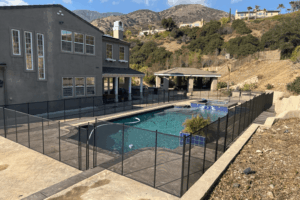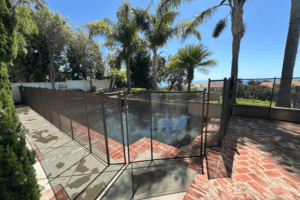
10 Questions to Ask Before Buying a Pool Safety Fence
Don’t buy a pool safety fence without asking these essential questions. This buyer’s guide helps you evaluate height, compliance, materials, installation, and more.

When it comes to kids and swimming pools, every parent knows that safety is of the utmost importance. It’s the driving force behind the rules we teach our little ones, the safety tools we install in our yards, and the pool laws that have shaped the swimming pool industry in recent decades.
The pool safety laws we have on the books today look quite different from the days of your parents and grandparents. Here’s a quick look at the steps lawmakers have taken to make residential and public pools safer for the kids in your life.
ASTM International Standards
ASTM International, formerly known as the American Society for Testing and Materials, has been around since well before the 1950s, but they regularly help to create product testing standards that help shape our safety laws for pools. These standards can help you determine which products are strong and safe enough to keep your family protected. Mesh fencing by All-Safe, for instance, actually exceeds ASTM standards. These standards identify mesh pool covers are another excellent option.
While ASTM isn’t technically a governing body, they do work with the United States’ Consumer Product Safety Commission (CPSC) to ensure that the safest product standards become legal requirements. If you want to make sure your pool adheres to any local laws, using ASTM-compliant products is a good place to start.
The Pool Safely Campaign
One of the reasons that pool laws are more comprehensive than they were in the 1950s is thanks to one government agency: the CPSC. This group was formed in 1972, and they’ve worked to improve product safety ever since. Swimming pools were at the forefront of their efforts; they issued a list of pool safety tips to the public as early as 1974!
These days, the CPSC makes swimming safer through their Pool Safely public education campaign. This campaign urges both pool industry professionals and consumers to be more careful when making or using swimming pools and swimming products, and it takes special care to encourage folk to follow any new pool safety laws.
The Virginia Graeme Baker Pool and Spa Safety Act
One of the most recent pool safety laws in the United States is the Virginia Graeme Baker Pool and Spa Safety Act (or VGBA), which passed into law in 2007. The law is named for Virginia Graeme Baker, granddaughter of former Secretary of State James Baker, who tragically drowned after being trapped underwater by a spa drain.
Under this pool law, all swimming pools and spas must be fitted with drain covers, and any pool with a large main drain must be outfitted with an emergency safety feature, such as a safety vacuum release system (SVRS). Thanks to the VGBA, children and adults use their pools and spas should be much safer for the future.
Your Local Laws
Of course, like many of the rules and regulations here in the U.S., the pool laws for your family will vary according to the state where you live. If you’re installing a new swimming pool — or if you haven’t made any upgrades to your pool in several years — look into the local laws for your area and make sure your pool meets the current safety standards!
Install a Pool Safety Barrier
Most states and municipalities require a safety barrier of some kind to prevent unauthorized entry and accidental injury in pools. That may be a pool fence, pool net, or pool cover. You can get a free consultation and quote on installing one of these vital safety barriers on your pool when you contact your local All-Safe dealer.

Don’t buy a pool safety fence without asking these essential questions. This buyer’s guide helps you evaluate height, compliance, materials, installation, and more.

Understand how local pool fence codes work and what to check before installation. This beginner’s guide simplifies requirements so your safety barrier complies and protects effectively.

Learn the truth behind common pool safety myths and make better decisions to protect your family with fact‑based guidance on fences, barriers, and maintenance.
Enter your zip code to locate an independent installer in your area
Enter your zip code to locate an independent installer in your area

Due to the many variations in monitors, phones, and browsers, color samples and product examples may appear different on different screens. Computers and mobile devices are not all calibrated equally and color reproduction on the Internet is not precise. The same is true for printed items such as brochures and other sales literature.
In addition, the colors of our products photograph differently under different lighting conditions. For example, photos taken in full sunlight will vary from photos taken on a cloudy or overcast day. Similarly, shadows from nearby objects can affect the color and transparency of our products. If a precise color or specific shade is important, please inspect the actual color of your product prior to installation.
Many of our products’ materials are not available through typical stores and vendors and therefore must be custom manufactured specifically for our use. In order to control costs and provide you with the best value possible, our raw materials are produced in large batches and can often take several months to receive. The colors of our materials can, and often do, vary slightly from batch to batch. Although we make every effort to minimize color variations, we cannot be responsible for these differences when they occur. If a precise color or specific shade is important, please inspect the actual color of your product prior to installation.
For example, we use the name “putty” to describe some of our products. Your idea of the color “putty” may be different than someone else’s idea of “putty”. In addition, products may have the same color name but may not be the exact same color. For example, we have different shades of “black”. Please do not order using color names as your only guide. If a precise color or specific shade is important, please inspect the actual color of your product prior to installation.
If it is important that your product be an exact color or shade, it is highly recommended that you inspect the actual product prior to its installation and address any concerns with your local independent installer. Most independent installers do not offer refunds or accept returns due to color variations.